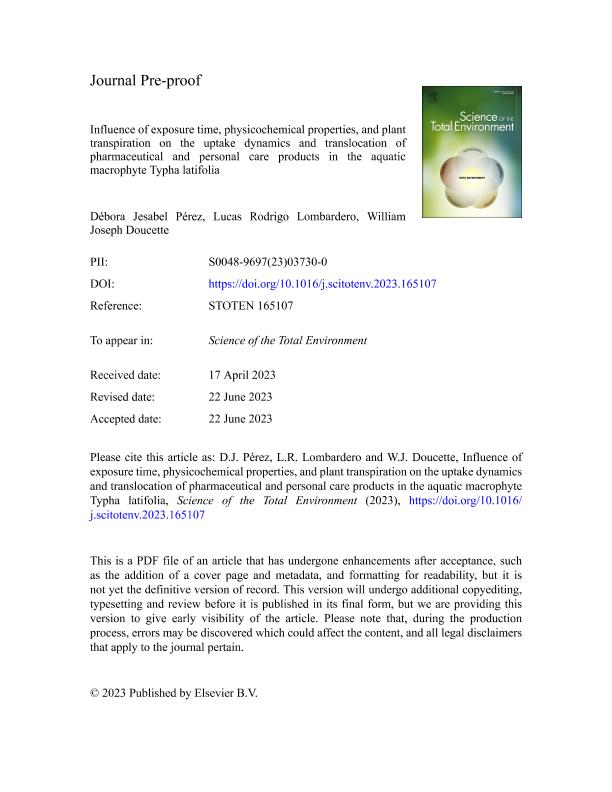Artículo
Influence of exposure time, physicochemical properties, and plant transpiration on the uptake dynamics and translocation of pharmaceutical and personal care products in the aquatic macrophyte Typha latifolia
Fecha de publicación:
20/10/2023
Editorial:
Elsevier
Revista:
Science of the Total Environment
ISSN:
0048-9697
Idioma:
Inglés
Tipo de recurso:
Artículo publicado
Clasificación temática:
Resumen
Typha latifolia is widely used as a phytoremediation model plant for organic compounds. However, the dynamic uptake and translocation of pharmaceutical and personal care products (PPCPs) and their relationship with physicochemical properties, such as lipophilicity (LogKow), ionization behavior (pKa), pH-dependent lipophilicity (LogDow), exposure time and transpiration, are scarcely studied. In the current study, hydroponically grown T. latifolia was exposed to carbamazepine, fluoxetine, gemfibrozil, and triclosan at environmentally relevant concentrations (20 μg/L each). Eighteen out of thirty-six plants were exposed to the PPCPs and the other eighteen were untreated. Plants were harvested at 7, 14, 21, 28, 35, and 42 days and separated into root, rhizome, sprouts, stem, and lower, middle, and upper leaf sections. Dry tissue biomass was determined. PPCP tissue concentrations were analyzed by LC-MS/MS. PPCP mass per tissue type was calculated for each individual compound and for the sum of all compounds during each exposure time. Carbamazepine, fluoxetine, and triclosan were detected in all tissues, while gemfibrozil was detected only in roots and rhizomes. In roots, triclosan and gemfibrozil mass surpassed 80% of the PPCP mass, while in leaf carbamazepine and fluoxetine mass represented 90%. Fluoxetine accumulated mainly in the stem and the lower and middle leaf, while carbamazepine accumulated in the upper leaf. The PPCP mass in roots and rhizome was strongly positively correlated with LogDow, while in leaf it was correlated with water transpired and pKa. PPCP uptake and translocation in T. latifolia is a dynamic process determined by the properties of contaminants and plants.
Archivos asociados
Licencia
Identificadores
Colecciones
Articulos (IPADS BALCARCE)
Articulos de INSTITUTO DE INNOVACIÓN PARA LA PRODUCCIÓN AGROPECUARIA Y EL DESARROLLO SOSTENIBLE
Articulos de INSTITUTO DE INNOVACIÓN PARA LA PRODUCCIÓN AGROPECUARIA Y EL DESARROLLO SOSTENIBLE
Articulos(IIMYC)
Articulos de INSTITUTO DE INVESTIGACIONES MARINAS Y COSTERAS
Articulos de INSTITUTO DE INVESTIGACIONES MARINAS Y COSTERAS
Citación
Pérez, Débora Jesabel; Lombardero, Lucas Rodrigo; Doucette, William Joseph; Influence of exposure time, physicochemical properties, and plant transpiration on the uptake dynamics and translocation of pharmaceutical and personal care products in the aquatic macrophyte Typha latifolia; Elsevier; Science of the Total Environment; 896; 20-10-2023; 1-47
Compartir
Altmétricas




